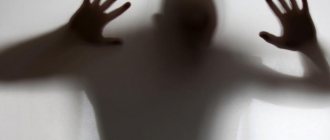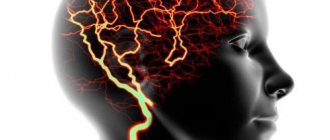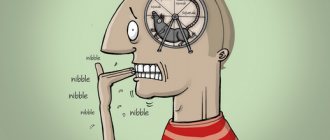Life is full of changes and events. Some of them make us happy, others make us unhappy, and others completely pull the rug out from under us. Keeping your sanity in a situation when the whole world around you is collapsing is incredibly difficult, and, unfortunately, not everyone succeeds. The consequence of this is various mental disorders.
One of them is acute polymorphic psychotic disorder. It can be cured if you consult a specialist in time, but to do this you need to know the reasons that stimulate its occurrence, as well as the symptoms of the disease.
Signs of psychosis without symptoms of schizophrenia
Signs of a psychotic disorder without symptoms of schizophrenia include:
- hallucinations;
- delirium of any nature;
- emotional confusion with the experience of either happiness, anxiety, or extreme irritability and anger;
- confusion;
- incorrect recognition of persons, places, events;
- sudden changes in activity.
Psychosis is a potentially destructive condition.
If manifestations persist for more than three months, one should talk about the chronic course of the disease and reconsider the diagnosis.
Symptoms of schizophrenia-type psychosis
With schizophrenia-like mental disorder, the symptoms are not as variable as in the variant described above. These include:
- delusions of various types;
- delusional ideas;
- “echo thoughts” and their supposed openness;
- hallucinations (auditory, visual);
- intermittency of speech, strange neologisms;
- catatonia (freezing, agitation, stupor, “waxy flexibility” of the limbs and body);
- apathy, lack of expression of emotions.
The main difference between such psychosis and schizophrenia will be its duration of up to one month. If the delusional picture, hallucinations and other above-mentioned symptoms persist for more than a month, then a diagnosis of “schizophrenia” is made, while organic damage to brain cells and the use of psychoactive substances are excluded.
Classification of mental disorders according to WHO
According to the approved WHO classification, all mental and psychotic disorders are divided into categories and types due to their development and the predominance of clinical manifestations.
Classification by etiology and causes
The first includes disorders of cognitive qualities or those occurring with “symptoms-plus”: delusional and hallucinatory manifestations, sudden inconsistent changes in mood and emotions caused by strokes, consequences of TBI, diseases of a systemic nature.
The next group is persistent mental changes due to the abuse of alcoholic beverages or the use of substances with narcotic psychoactive properties that are not classified as narcotic: solvents, hallucinogens - household poisons, sleeping pills and sedatives.
Barbiturate poisoning can cause psychosis or death
The development of psychoses due to schizophrenia and schizotypal personality makes up the next large group.
The category of affective disorders includes conditions with sudden changes in mood. In addition to bipolar affective disorder, this includes mania with or without various psychotic manifestations, hypomania and depression with different etiological basis and course, as well as dysthymia and cyclothymia.
The group of phobias and neuroses includes disorders of a neurotic or psychotic nature in the form of chronic stress, panic attacks, paranoia, neuroses and phobias themselves, as well as somatically caused deviations. Phobias themselves are divided into:
- situational;
- specific.
Behavioral syndromes caused by physiological disorders include deviations in the level of appetite (both upward and downward - bulimia and anorexia, respectively), or those in terms of sexual reactions (such as excess libido, frigidity and the like).
It is customary to associate with personal and behavioral disturbances in adulthood both deviations in one’s own sexual identification (transvestism) and sexual preferences (sadomasochism, pedophilia, etc.), as well as the formation of pathological attractions and habits in connection with being in a certain personal or social situation, be it pyromania, passion for card games or the like.
The gradation of mental retardation includes conditions caused by congenital mental retardation with a decrease in such qualities of intelligence as thinking, memory, speech, and the ability to socially adapt, divided by severity into:
- lungs;
- moderately expressed;
- medium-heavy;
- heavy.
Inhibition of psychological development refers to the category of psychopathology, when a slowdown in mental development noted in early childhood due to brain damage does not progress further, stopping at a certain level of acquiring learning skills, speech and motor functions. But there is also no further evolution of psychological development.
The classification of psychoses is completed by a group of disorders of concentration and pathologically high activity, including various hyperkinesis. They manifest themselves as childish and adolescent disobedience, ignoring comments about hyperactivity, and, with an insistent demand for attention from an adult, aggressiveness.
Breakdown by manifestations and syndromes
According to the predominance of certain syndromes, personality mental disorders are divided into:
- schizoid;
- paranoid;
- dissocial.
The symptomatology of mental disorders lies in the instinctive “clinging” of the psyche to something familiar (assessed as firmly safe) when finding itself in an unfamiliar and therefore frightening situation.
Due to the greater flexibility and mobility of the female psyche, the signs of a mental disorder in women are particularly colorful and extraordinary tenacity of their existence with regular repetition of seizures, while in men symptoms of delusional ideas are often observed.
The main signs of a mental disorder fit into two leading syndromes:
- senestopathic;
- hallucinatory.
The first includes various disturbances of susceptibility, the second - varying degrees of hallucination activity.
Subtypes of senestopathies include both increased - exacerbation of susceptibility to ordinary stimuli (hypersthesia), and an inadequate decrease in the situation (hypoesthesia), or they are expressed by induced unnatural sensations in the form of tearing, burning, squeezing, bursting and similar manifestations.
Hallucinations may be of the following nature:
- true - with finding the missing object in real time and space, not “in the head” of the patient;
- pseudohallucinations – with the perception of the topic “in the body” of the patient;
- illusions - the perception of a real topic or object, but in a distorted form;
- metamorphopsia – distortion of the perception of the size and proportions of one’s own body.
Mental disorder is most powerfully depicted in the film “Terminator 2”, where the main character again and again sees the picture of the death of the world and her own body in a barrage of nuclear explosion, and the metamorphoses that occur with the “liquid metal” body of the killer robot in the series finale are a clear illustration of the phenomenon of metamorphopsia experienced by a patient with severe mental illness.
It is possible to change the rhythm and coherence of thought processes towards their inhibition or acceleration, thoroughness or incoherence, the presence of perseverations.
The patient may be susceptible to delusional ideas (with complete distortion of someone else’s idea with categorical rejection of a point of view different from his on this issue) or simpler manifestations of pathology - obsessive phenomena in the form of uncontrollable doubts, frightening memories, intrusive thoughts.
Violations of self-awareness are manifested by confusion, derealization or depersonalization.
Memory impairments are expressed by:
- paramnesia;
- dysmnesia;
- amnesia.
This category also includes sleep disturbances with or without disturbing dreams.
Obsessions associated with obsessive-compulsive disorder can be:
- distracted in the form of annoying calculations and other “pointless philosophizing”;
- figurative – the nature of fears and persistent desires;
- taking possession with wishful thinking;
- the nature of obsessive actions reminiscent of rituals.
This is a fairly complete, but not exhaustive list of all subtypes of mental disorders.
Features of manifestation in men
When studying the statistics of the manifestation of psychotic symptoms in men, which ultimately result in schizophrenia, it is clear that they are characterized by an earlier onset (18-25 years) than for females. And due to the greater prevalence of alcoholism among men, we can talk about a more frequent detection of alcoholic psychosis in them. Males with alcoholic psychosis are often characterized by delusions of jealousy, which are practically never found in women.
At the same time, men react with pronounced aggression
Treatment
To treat acute psychosis, it is necessary to hospitalize a person in a specialized hospital, since he loses control and can be dangerous both for others and for himself. In addition, the hospital conducts a medical examination to clarify the diagnosis.
Drug therapy used:
- antipsychotics as the main treatment tool;
- benzodiazepine tranquilizers to relieve severe anxiety;
- antidepressants for signs of depression;
- mood stabilizers for intense mood swings.
After recovery from the acute state, psychotherapy, social skills training and psychological correction are carried out to prevent post-psychotic anxiety-depressive state.
To achieve a positive result, it is very important to find a good specialist
Diagnosis and treatment of APPR in our clinic
To make a diagnosis, a conversation with a psychiatrist and clinical observation may be sufficient.
The prognosis for treatment of APPD with modern psychotropic drugs is favorable. For complete recovery, 2–4 weeks of treatment in a hospital clinic are required. Treatment of acute polymorphic psychotic disorder is carried out by psychiatrists and psychotherapists. The acute condition is relieved either on the day of hospitalization or 2-3 days after the start of treatment. The main method of treatment is medication, the auxiliary method is psychotherapeutic.
Drug treatment of acute polymorphic psychotic disorder is carried out under the supervision of the chief physician of our clinic, Alexey Viktorovich Bocharov, a recognized expert in the field of pharmacotherapy of mental disorders.
The main stage of treatment for APPD is therapy with first-line drugs (antipsychotics, neurometabolites, antipsychotics). After the acute condition is relieved, maintenance therapy and psychotherapeutic treatment are prescribed.
Consequences and prognosis
The consequences of “true” short-term psychoses depend on the genetic predisposition to diseases of this kind. In people who did not have schizophrenia in their family, when a psychotic disorder occurs due to severe stress, recovery occurs faster and up to 80% returns to the original mental level.
The consequence of acute psychotic disorders is often depression with an anxiety component.
The prognosis for 60-80% of people with long-term (up to three months) or recurring psychoses is unfavorable, as schizophrenia develops.
Information for family and friends
Recognizing the occurrence of APPR is not so difficult. You clearly know that there was very serious stress. And you see that the person either falls into euphoria, then withdraws and shows himself in severe depression. Signs of delirium are confusion and complete illogicality. It’s as if fragments of several monologues are in one, but none of them can be heard in their entirety. Patients may try to perform some actions without thinking about their illogicality. Run to work in the middle of the night, for example. One patient took a taxi at three in the morning and went to the cemetery because she was sure that her newly buried child was cold there. She carried a blanket with her. And this is OPPD without symptoms of schizophrenia. If there is a polymorphic psychotic disorder with symptoms of schizophrenia, then delusions with a relatively stable plot also arise. This may be delusions of persecution and influence, symptoms of the sound of thoughts, their openness to others, reading the thoughts of others. Another sign is chaotic movements. The patient can put on his pants for 10 minutes. The arms and legs are doing something else in parallel.
It should be noted that everything observed is a protective reaction of the psyche and nervous system. Delusions and hallucinations are a way of turning on self-correction mechanisms. However, as in all cases when it comes to the unconscious, its manifestations in consciousness cannot be clearly predicted. Therefore, the intervention of psychiatrists, and subsequently psychotherapists, is necessary.
Returning to the behavior of the woman who was carrying a blanket to the cemetery, we can draw several conclusions. A person acts this way because he cannot do otherwise. She is simply torn apart from the inside, she must do something for her child, and he has already died. If a trip to the cemetery and doing something calms her down, then it even plays a constructive role. She will make sure she doesn't do this again. But we don’t know how events will develop, since she is in a state of jumping emotions and mental activity. She could commit suicide there. The question is what to do in this case. If one of your close people is a good non-professional psychologist, then he holds the cards. Maybe it will be possible to calm down the unfortunate woman simply by talking. However, then hospitalization is classified as necessary. Do not force such a person, of course, but do everything to ensure that the patient gives consent. In the most acute cases, you need to call an ambulance...
Support from loved ones during treatment of the disorder is very important
And for your information... The behavior of such patients can be aggressive, but this happens extremely rarely. There are many examples when people with APPR are hospitalized in a neurological rather than a psychiatric department. So you shouldn’t be afraid of turning to specialists using the formula “they’ll put you in a mental hospital.” In the end, all this will most likely be framed as a “nervous breakdown”, and then everything will be fine. With or without symptoms, it is not schizophrenia.
paranoid psychosis
The condition appears against the background of paranoid schizophrenia, chronic delusional disorder, intoxication, including alcohol.
The type of psychosis with paranoid delusions may include the following ideas:
- persecution;
- influences from outside and inside;
- interpretation;
- accusations;
- relationship;
- damage;
- the presence of a disease (hypochondriacal delirium);
- poisoning or killing by other means.
A person is so convinced that he is right that no reasonable arguments can convince him. In addition to the delusional picture, there may be a significant increase in anxiety, motor restlessness, the emergence of fear of death and apathy, and behavior changes.
There is a pronounced disturbance in the perception of surrounding reality
Causes
Psychotic disorders tend to arise mainly in adolescence, when a person is developing as an individual. In adults - due to personal characteristics (for example, infantility, fear of society, etc.). In old age, fear of death plays a big role. Of course, these types of psychoses, so to speak, are relatively physiological, although they do not always occur, and with medication and psychotherapy they can go away on their own.
But psychotic states that arise against the background of the progression of a particular mental illness can be due to:
- Hereditary predisposition;
- Mental trauma that served as an impetus for the development of psychosis;
- Unfavorable environmental, social, living conditions;
- Severe emotional stress;
- Physical and mental fatigue;
- Drug abuse;
- Infectious process in the body;
- Suffered traumatic brain injuries;
- Drug and/or alcohol addiction.
Alcohol psychosis
A psychotic state develops due to alcohol abuse. Alcoholic psychoses can be divided depending on the main symptom:
- delirium (impaired consciousness with hallucinations, delusions, motor restlessness, fear, emotional reactions, but orientation in one’s personality against the background of abstinence);
- hallucinosis (prevalence of visions against a background of severe anxiety and fear);
- delusional psychosis (against the background of heavy drinking or a hangover, persistent ideas of persecution, jealousy, and others appear);
- encephalopathy (a combination of psychotic and neurological manifestations in advanced alcoholism with amnesia, polyneuropathy, pseudoparalysis);
- pathological intoxication (impaired consciousness with severe anxiety, anger, even rage and aggression against the background of very small doses of alcohol).
Differential diagnosis
A psychiatrist must make a differential diagnosis between a psychotic disorder without signs of schizophrenia and psychosis directly associated with it.
A psychotic disorder without signs of schizophrenia can occur as a result of gross disturbances during childbirth, with prolonged fasting, vitamin deficiency, or after infectious diseases.
With this pathological condition, the patient is worried about persecution mania, increased anxiety, changes in motor activity, and cyclical mood. The patient takes a long time to answer questions and is inhibited.
An acute psychotic state with signs of schizophrenia has similar symptoms, but the hallucinations are more persistent, voices appear in the head, and the thought echo phenomenon is characteristic (fear that people are reading or stealing thoughts and giving the patient their own).
It is also quite difficult to distinguish between the psychotic and non-psychotic levels. In neurotic conditions, a person is able to understand that he is sick and can consult a doctor himself. But with mental illnesses, patients’ criticism is absent or dulled, which can also make it difficult to diagnose between these two levels.
Affective insanity
A disease associated with mood changes in the form of phases of depression and mania. It develops more often at a young age under the influence of stress, genetic, and neuroendocrine factors. The number and frequency of phase changes are individual, and the course of the disease is difficult to predict. They last from several weeks to two years with a predominance of depressive periods.
During the manic stage of the disease, the mood is elevated, motor disinhibition is revealed, the person is excited and full of ideas. During the depressive stage, there is no mood, apathy is observed, thought processes and movements slow down.
A sick person must undergo a full examination











